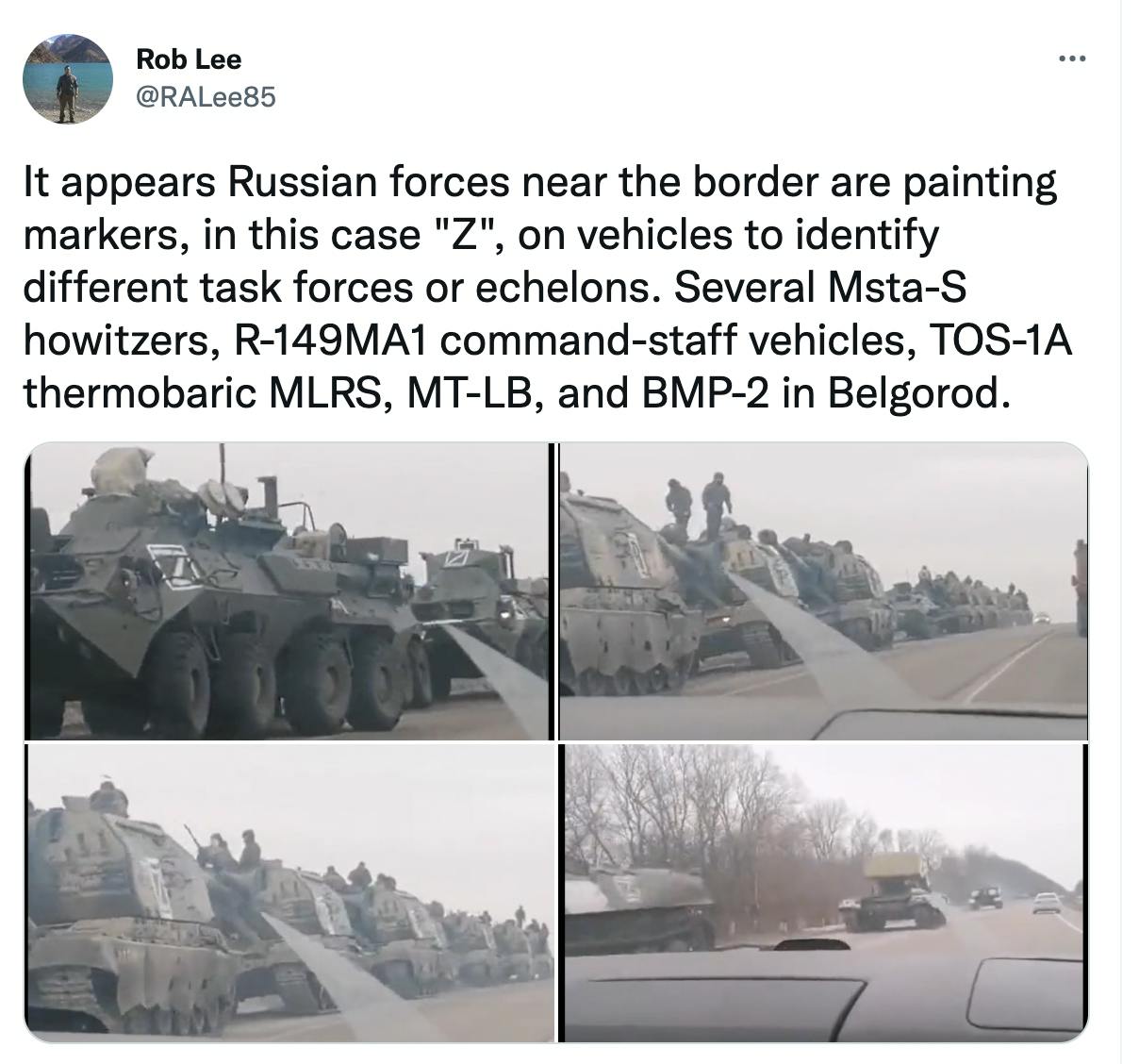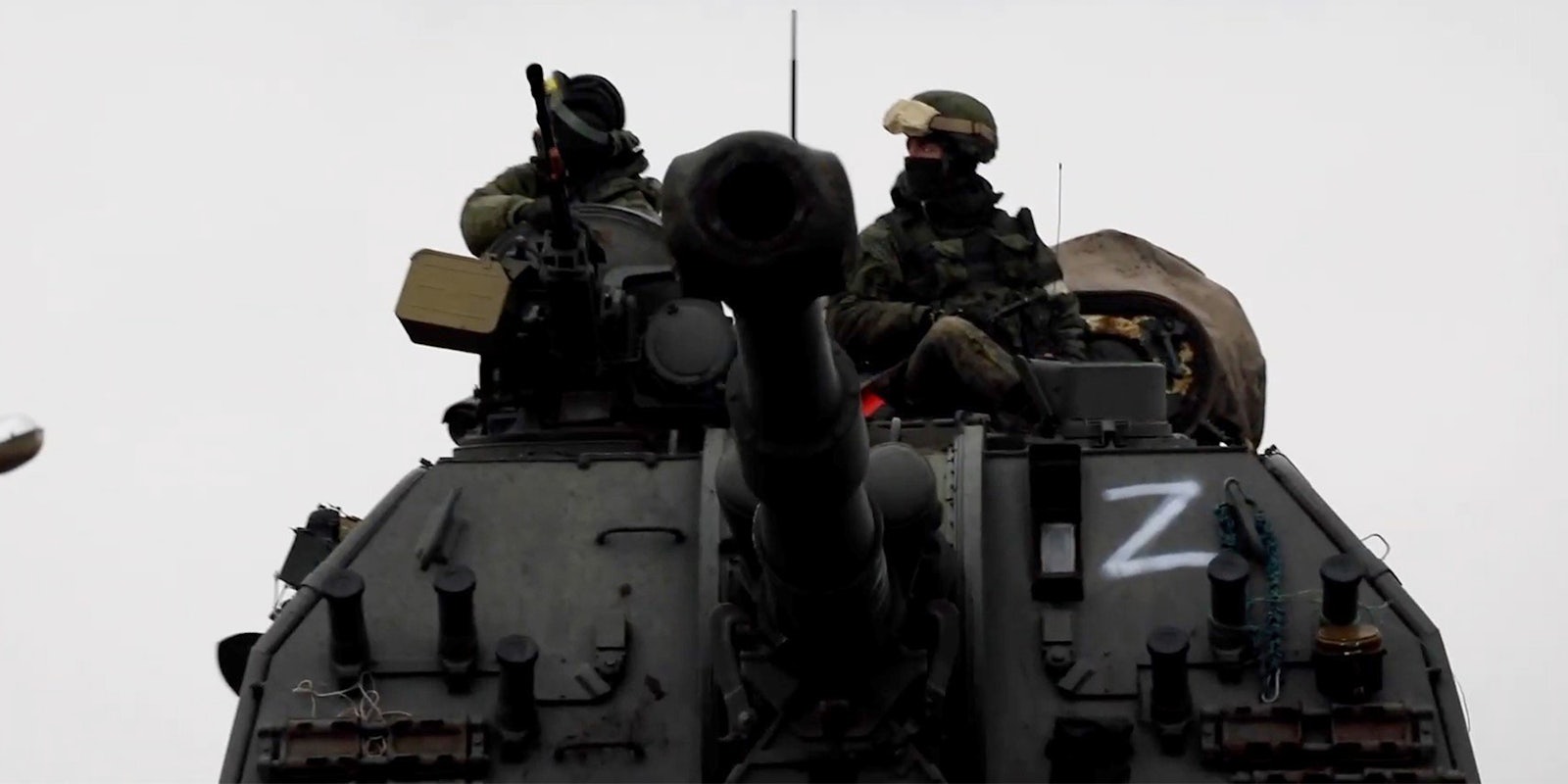A mysterious letter emerges and is quickly adopted as a symbol of nationalism and a desperate struggle against dark forces. Those who support the movement behind the letter begin to display it publicly on social media, a sign that they are on the same team. Opponents of what the letter represents see it as a symbol of violent, destructive hate, worn by conspiracy theorists and racists. But those who wear the letter know better—and more and more people seem to be displaying it every day.
Is it QAnon in America? Or Z in Russia?
As photos of Russia’s military buildup on the Ukrainian border went public, the stark white symbols on their vehicles immediately stood out. Some were circles, others upside-down triangles. But most noticed was the letter “Z,” usually in thick white paint and sometimes surrounded by a square. Because the letter Z isn’t native to the Cyrillic alphabet, Russia experts and military strategists had no idea what it meant.

Was it a deconfliction marking meant to reduce friendly fire incidents? Or did the various symbols indicate which attack routes the vehicles were taking? Some speculated it was short for “zapad,” the Russian word for “west” or “Za pobedy,” usually translated as “for victory.”
Others guessed that the Z stood for “Zelenskyy”—the last name of Ukraine’s president.
Whatever the meaning, the Z symbol started to be used by Russian supporters of the invasion and began appearing seemingly everywhere there. Sometimes they were made with a few pieces of white tape on a car window, and sometimes on mass-printed shirts. Zs were spray-painted on the doors of dissenters and flashed by patriotic, Vladimir Putin-supporting athletes. People stood in Z formations to be posted on social media with pro-Russia hashtags. It’s become the marker of choice for Putin’s repressive, increasingly hermit-like dictatorship.
It’s unclear if it is a movement pushed by the Kremlin or not. Reports vary. But it has swiftly been adopted in a way that makes its future untenable regardless of whether it is government-backed propaganda.
The parallels to the Q of the QAnon movement seem obvious. A simple letter representing so much more—hope to supporters, violent hate to critics. Love for a proto-fascist authoritarian in the name of democracy. Both movements seem inherently antisemitic, with Q believers obsessing over the evil string-pulling of George Soros and the Rothschilds and Russians believing that Putin’s invasion is meant to “denazify” Ukraine.
And the similarity in the use and iconography behind the two letters inspired a slew of pundits to observe something along the lines of “Z is the new Q.”
“Z is to Russian disinformation what Q is to American conspiracy theories,” wrote one.
Unfortunately, it’s the wrong interpretation. While both have dangerous facets, Z is being thrust upon a population that, while sometimes complicit, doesn’t have a choice. Q, however, developed organically among people who wanted to believe. While the dangers of both are real, they are profoundly different. The staying power of Z most likely isn’t there, but the death it’s caused is vast. With Q, it may not leave American politics for some time, but the scale of its desire for violence is much smaller.
Both can be existential threats in nature, but that doesn’t mean they are the same.
Nationalist movements thrive on symbols to unify the people in times of war. Think of the ubiquity of American flag lapel pins post-9/11. Or Nazi Germany’s embrace of the swastika in everyday life. At best, these symbols can bring people together. At worst, they can inspire violence and slavish devotion to a dictatorial figure—something that both Q and Z would seem to have in common.
But with Q and Z, the breathless comparisons are a stretch, a desire for an easy link between Russian nationalism and the American far-right, some of which has embraced Putin’s invasion. It’s true that a great number of Trump-loving conservatives believe in some aspects of QAnon and also support Putin. Some are even embracing Z iconography. That’s not inherently in the name of Putin, but rather part of their own conspiratorial obsessions, which now include the mistaken belief that Ukraine is harboring bioweapons and is a haven of child trafficking.
While Q has wrought havoc and destruction, its followers also believed in the greater mission. Z, it seems, is a way to whitewash a murderous invasion, an astroturfed showing of support. The outsized attention it almost instantly garnered practically speaks to the inorganic nature of its following. The Z symbol has been public for less than a month and has already gotten press coverage around the world, while supposedly inspiring millions of Russians.
At just a few weeks old, QAnon was still virtually unknown except to a few acolytes on 4chan. Not a single major outlet had written about. Meanwhile, dozens of major websites and pundits have already attempted to explore Z’s role in the Russian invasion.
In that time in private, Q was able to build itself into what it’s become, discarding elements that didn’t work, and growing as a movement that stridently believed in it. Z, on the other hand, arrived fully formed and readymade to be adopted as a symbol of propaganda and nationalist war fever.
Q was secretive and mysterious by design, which helped its allure and appeal. Believers had to come to their own understanding of support and belief. Z came from the top-down, with the Putin propaganda machine likely deliberately behind its growth to gain support for an unpopular and costly war of choice.
It led to easy adoption. Whereas Q has never been fully embraced by mainstream conservatism at large, Z already has support in the Russian government. Q believers fought tooth and nail for the movement to gain a foothold in the political landscape. That’s why QAnon has such staying power. Embracing the Z requires no work other than loving Russia.
Even with its main figureheads long departed, and no one spearheading an identity from the top, QAnon isn’t disappearing. Z, when the war in Ukraine ends, may linger as a symbol for support of Putin. But as a movement that aims to keep him in power, that seems unlikely.
But the most crucial reason that the two aren’t really alike is that the people dying under the weight of what the Z represents are real, while there is no “Q team” and never have been. The suffering of families dealing with Q is real, but it can’t be compared to the destruction of cities and the deaths of children by the Russian army.
Z is quickly becoming the symbol of choice for a repressive regime that brutally crushes dissent and violates the sovereignty of other nations. But for all their ideation, the deep state that Q believers spend year after year trying to take down is not real. QAnon believers were cheering on a fight against a fake enemy they could never confront in battle (until, at least, Jan. 6). Z supporters are praising real slaughter. Nothing Q has ever predicted has come to pass, and its hopelessly complex puzzles and riddles have no answer. Z does have a simple goal. End Ukraine.
To equate Q and Z is to say that what is happening in Ukraine is akin to the far-right storming the U.S. Capitol. There’s just no equivalence, even if they both use letters, and they both have violent ideation. The scale just isn’t the same.
Those who wear the Z support the systematic destruction of a nation of 44 million people. Those who wear the Q just wanted Hillary Clinton to go to prison. No matter what Q morphed into, it isn’t indiscriminate war.


